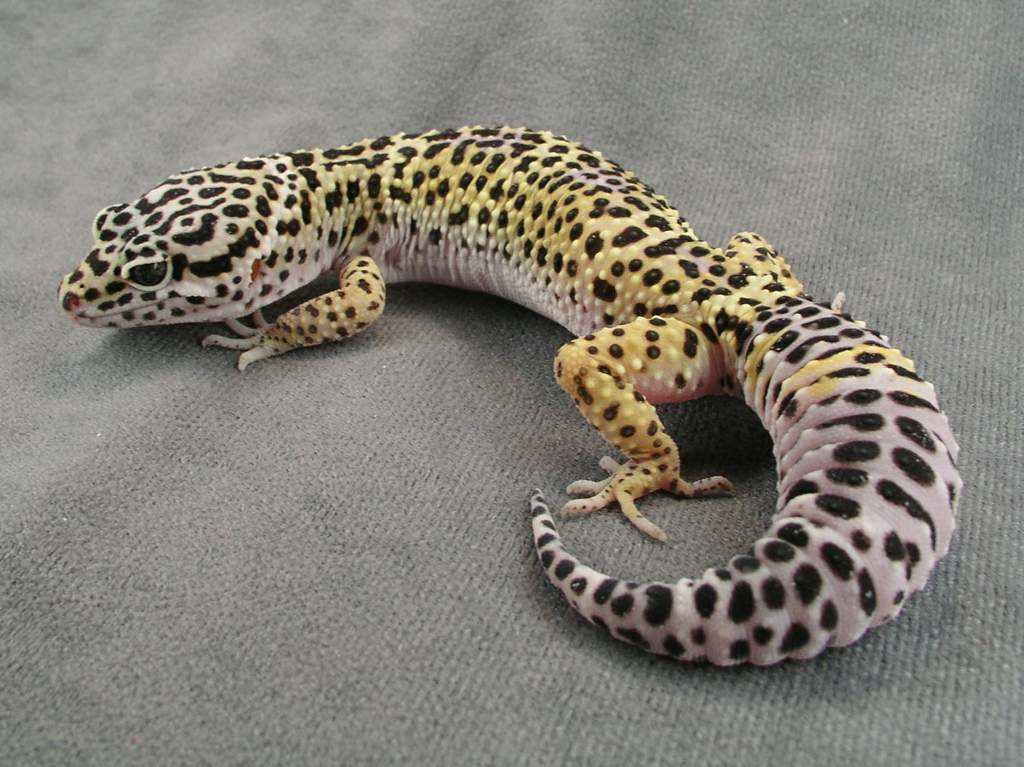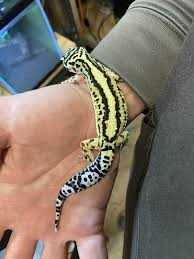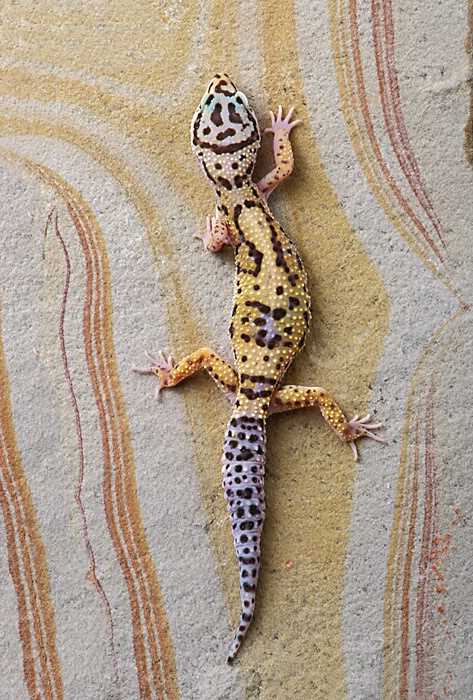
As a reptile owner, taking care of your leopard gecko’s tail is crucial to its overall well-being. The tail serves many important functions, including fat storage, balance, and communication. Follow these tips to ensure your gecko’s tail stays healthy and intact.
Diet: A balanced diet is essential for a healthy tail. Provide your gecko with a variety of insect prey, such as crickets, mealworms, and waxworms. These insects should be gut-loaded with nutritious foods before being fed to your gecko. Additionally, dusting the prey with calcium and vitamin D3 supplements helps support tail health.
Vet Check-ups: Regular visits to the vet are crucial for maintaining your leopard gecko’s tail. A knowledgeable reptile veterinarian can examine the tail for any signs of injury, infection, or metabolic bone disease. They can also provide guidance on tail care and proper shedding techniques.
Healthy Shedding: A gecko’s tail is prone to shedding issues, which can lead to tail loss or damage. To promote healthy shedding, provide a humid hide in the enclosure. This allows your gecko to easily shed its old tail skin. If you notice your gecko struggling to shed its tail, consult a vet for assistance.
Preventing Tail Drops: Leopard geckos have the ability to drop their tails as a defense mechanism. However, tail dropping can be stressful for the gecko and should be avoided if possible. Handle your gecko gently and avoid grabbing or pulling its tail. If the tail does drop, ensure a clean environment and monitor for any signs of infection.
The Importance of a Healthy Tail for Your Leopard Gecko
1. Balance and Stability
A healthy tail is essential for maintaining balance and stability. Leopard geckos rely on their tails to help them maneuver and navigate their environment. A strong and healthy tail allows them to climb, jump, and move with precision.
2. Communication
The tail of a leopard gecko is also an important means of communication. It can be used to convey various messages to other geckos, such as signaling aggression or indicating a desire to mate. A healthy tail ensures that your gecko is able to effectively communicate with its fellow reptiles.
3. Energy Storage
4. Regeneration
5. Shedding
During the shedding process, a leopard gecko’s tail requires special attention. The old skin needs to be shed properly to avoid constricting the blood flow and potentially causing harm to the tail. Regular monitoring of the shedding process and taking necessary steps to assist in the shedding of the tail is essential for maintaining its health.
Tips for Proper Diet and Nutrition for a Healthy Leopard Gecko

Proper diet and nutrition play a crucial role in maintaining a healthy leopard gecko. The diet of a leopard gecko should consist of a variety of live insects to provide them with the essential nutrients they need to thrive. Here are some tips for ensuring your leopard gecko receives the proper diet and nutrition:
- Feed them a balanced diet: A leopard gecko’s diet should consist primarily of gut-loaded insects such as crickets, mealworms, and dubia roaches. These insects should be dusted with a calcium supplement to ensure proper bone growth and development.
- Vary their food: Offering a variety of insects will help provide different nutrients and prevent nutritional deficiencies. You can also include occasional treats such as waxworms or silkworms to add variety to their diet.
- Provide a shallow dish of water: Leopard geckos should have access to clean, fresh water at all times. The water dish should be shallow to prevent drowning, and the water should be changed regularly to ensure its cleanliness.
- Monitor feeding habits: Pay attention to how much and how often your leopard gecko is eating. If they are not showing interest in food or are consistently refusing to eat, it may be a sign of an underlying health issue, and a visit to a reptile vet is recommended.
- Observe their body condition: Keeping an eye on your leopard gecko’s body condition is crucial. They should have a healthy weight and a clear, vibrant skin. If you notice any significant weight loss, bloating, or changes in skin appearance, consult a vet for further evaluation.
- Regular vet check-ups: Regular visits to a reptile vet are essential for maintaining the overall health of your leopard gecko. A vet can provide guidance on proper diet and nutrition, as well as detect any potential health issues before they become serious.
By following these tips and providing your leopard gecko with a proper diet and nutrition, you can ensure that they maintain a healthy tail and overall well-being. Remember to consult a reptile vet for personalized advice and guidance tailored to your leopard gecko’s specific needs.
Tips for Handling and Stimulation of a Healthy Leopard Gecko Tail
A leopard gecko’s tail is an important part of its overall health and well-being. Proper handling and stimulation can help keep the tail healthy and prevent any potential issues. Here are some tips to ensure a healthy gecko tail:
1. Gentle and Proper Handling
2. Regular Interaction

Leopard geckos are naturally curious animals and thrive on regular interaction with their owners. Spend time handling and playing with your gecko to provide mental stimulation and exercise. This can help prevent stress and encourage a healthy tail.
3. Tail Waving and Exercise
Leopard geckos often wave their tails as a form of communication and to aid in balance. Encourage this natural behavior by providing plenty of space and opportunities for your gecko to exercise. This can be done with the use of branches, rocks, and other climbing structures within their enclosure.
4. Avoid Excessive Vibrations
Excessive vibrations can stress a leopard gecko and potentially lead to tail problems. Avoid placing the gecko’s enclosure near loud appliances or other sources of continuous vibrations. This will help maintain a healthy tail and overall well-being for your reptile.
5. Provide Hiding Spots
Leopard geckos require hiding spots within their enclosure to feel safe and secure. These hiding spots should be large enough for the gecko to comfortably fit inside and should be placed in various locations to encourage exploration and exercise. Hiding spots will help reduce stress and promote a healthy tail.
Maintaining a Clean Enclosure for a Healthy Leopard Gecko Tail
Proper care and maintenance of a leopard gecko’s enclosure is crucial for promoting a healthy tail. Keeping the enclosure clean helps prevent the growth of bacteria and parasites that can cause tail problems.
1. Regular Cleaning
2. Substrate Choice
3. Spot Cleaning
Perform regular spot cleaning by removing any visible waste or soiled substrate. This will help prevent the buildup of bacteria and reduce the risk of tail infections. Use a reptile-safe disinfectant to clean the affected area.
4. Maintaining Proper Humidity
Leopard geckos require specific humidity levels to keep their skin and tail healthy. Maintain the recommended humidity level of 20-40% by misting the enclosure with water or using a reptile humidifier. This will help prevent excessive shedding and tail problems.
5. Preventing Mold and Odor
A clean enclosure not only keeps the tail healthy but also prevents the growth of mold and reduces unpleasant odors. Remove any wet or soiled substrate immediately to prevent the growth of mold. Use odor-absorbing products like activated charcoal or reptile-safe deodorizers to keep the enclosure smelling fresh.
By following these guidelines and maintaining a clean enclosure, you can ensure the overall health and well-being of your leopard gecko and promote a healthy tail. Regular cleaning, proper substrate choice, spot cleaning, maintaining humidity levels, and preventing mold and odor will contribute to a clean and healthy environment for your reptile companion.
Tips for Preventing Tail Injuries in Leopard Geckos
The tail of a leopard gecko serves several important functions. It acts as a fat storage reserve, helps with balance, and plays a crucial role in their mating process. A healthy tail indicates a healthy gecko, so it’s vital to provide proper care for this appendage.
Creating a Safe and Stimulating Environment
One of the best ways to prevent tail injuries is to provide a suitable environment for your leopard gecko. The enclosure should have enough space for them to move around freely, ensuring that their tail doesn’t get caught or trapped. Adding various hideouts and climbing structures will help prevent boredom, ensuring they don’t injure their tail due to stress or aggression.
Handling with Care
When handling a leopard gecko, it is crucial to be gentle and cautious. Avoid pulling or tugging their tail as it can cause severe injury. Instead, support their body fully and allow them to move at their own pace. If you need to pick them up, it’s best to let them walk into your hand rather than grabbing their tail.
Proper Husbandry and Hygiene
Regularly cleaning and maintaining the enclosure is crucial for preventing tail injuries. Dirty enclosures can lead to bacterial infections or stuck shed, which can cause damage to the tail. Ensure that the substrate used in the enclosure is safe and won’t cause any harm to the tail. Clean the enclosure regularly and monitor the humidity levels to prevent any tail-related issues.
Monitoring the Shedding Process
Leopard geckos regularly shed their skin, including the skin on their tail. It is essential to monitor the shedding process and ensure that there are no difficulties in shedding the tail. If you notice any signs of retained shed or stuck shed, it is best to consult a reptile veterinarian. They can provide guidance on how to assist the shedding process and prevent any tail injuries.
Regular Veterinary Check-ups
To keep your leopard gecko’s tail and overall health in check, regular visits to a reptile veterinarian are necessary. They can examine your gecko, check for any signs of tail problems, and provide appropriate treatment if needed. A veterinarian specialized in reptile care can offer valuable advice on tail maintenance and ensure the well-being of your gecko.
Monitoring the Shedding Process for a Healthy Leopard Gecko Tail

Here are some tips to help you monitor the shedding process and ensure the health of your leopard gecko’s tail:
- Observe the signs of impending shedding: Before shedding, you may notice a change in your gecko’s behavior. They may become less active and may also lose their appetite. Their skin may also appear dull and opaque.
- Provide a moist hide: Leopard geckos need a humid environment to aid in the shedding process. A moist hide can help them remove their old skin more easily. Place a damp paper towel or moss in a hide in their enclosure.
- Watch for signs of stuck shed: Sometimes, a small piece of shed skin may remain stuck on your gecko’s tail. This can constrict the blood flow and lead to serious complications. If you notice any stuck shed, you can gently try to remove it with a damp cotton swab or seek veterinary assistance if necessary.
- Provide a proper diet: A well-balanced diet is essential for the overall health of your leopard gecko, including their tail. Make sure to provide them with a variety of live insects, such as crickets and mealworms, dusted with a calcium supplement.
- Monitor the shedding frequency: A healthy leopard gecko should shed its skin approximately once every four to eight weeks. If you notice that your gecko is shedding too frequently or not shedding at all, it may indicate an underlying health issue that requires veterinary attention.
Regular vet check-ups are also important to ensure the overall health of your leopard gecko, including their tail. A reptile vet can provide a thorough examination and address any concerns you may have regarding the shedding process.
By following these tips and monitoring the shedding process, you can help maintain a healthy tail for your leopard gecko. Remember to provide the proper care and attention to ensure the overall well-being of your reptile companion.
Regular Veterinary Check-ups: A Key Component of Gecko Care
Regular vet check-ups play a vital role in monitoring and maintaining the health of your leopard gecko’s tail. Just like any other part of their body, the tail is susceptible to various conditions that can negatively impact their well-being.
During a veterinary check-up, a skilled reptile veterinarian will thoroughly examine your gecko’s tail, paying close attention to any signs of injury or disease. They can also provide guidance on proper diet and nutrition to ensure your gecko is getting the necessary nutrients for a healthy tail.
Additionally, a vet can advise on proper handling and stimulation techniques to promote tail health. It’s important to handle your gecko gently and avoid pulling on their tail, as this can lead to injury or stress. A vet can teach you proper techniques for handling your gecko to minimize the risk of tail problems.
Regular check-ups also allow your veterinarian to monitor the shedding process of your leopard gecko. Shedding is a normal and necessary part of a gecko’s life, but difficulties in shedding can indicate underlying health issues or improper husbandry. A vet can help you identify and address any shedding problems to ensure a healthy tail.
Signs of Tail Problems

However, it is essential to ensure that the tail is healing properly. Examine the area where the tail was lost for any signs of infection, such as redness, swelling, or discharge. If any of these symptoms are present, it is recommended to consult a reptile veterinarian for further evaluation and treatment.
Proper diet and care play a significant role in the healing process. Ensure that your gecko is receiving a well-balanced diet with adequate vitamins and minerals to support tail regrowth. A healthy diet consisting of a variety of insects, such as crickets and mealworms, is essential for the overall wellbeing of your gecko.
Additionally, regular vet check-ups are crucial for monitoring the progress of tail regrowth and ensuring that there are no underlying health issues. Your veterinarian can provide guidance on proper care and diet for your gecko to promote tail healing and prevent any further complications.
During the shedding process, pay close attention to your gecko’s tail. Shedding can sometimes be a challenging process for leopards geckos, and the tail area is particularly susceptible to issues like retained shed or stuck shed. If you notice any difficulties in shedding or abnormalities with the tail, it is essential to provide proper humidity levels and gentle assistance to help your gecko successfully shed its skin.

I’m Lena Adams—a product of an unconventional upbringing in the African wilderness. My father, a daring explorer of African wildlife, sparked my fascination with reptiles, a passion that intertwined with the tragic loss of my mother during an expedition, leaving an indelible mark on my life. Driven to understand the creatures that captivated my parents, I embarked on my journey, sharing insights about reptiles, frogs, and lizards on my website. Through my explorations and conservation efforts, I honour my family’s legacy while seeking connections—to the creatures, nature, and the mother whose presence I yearn to understand.
